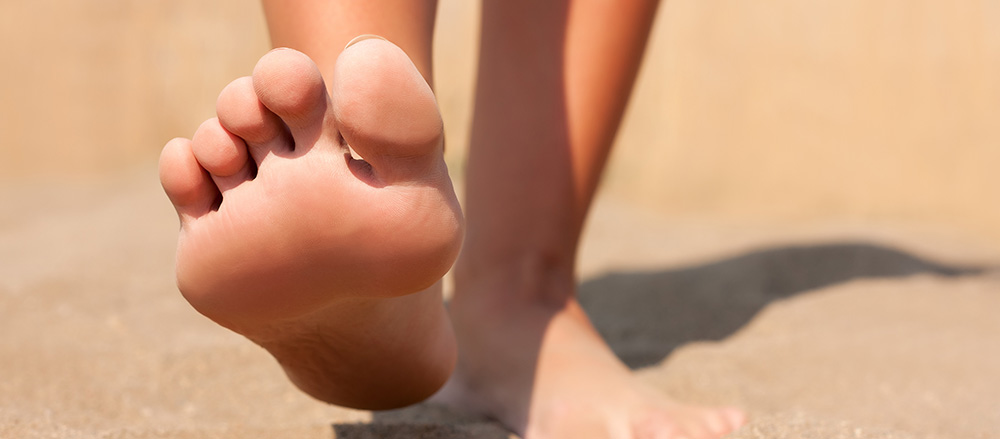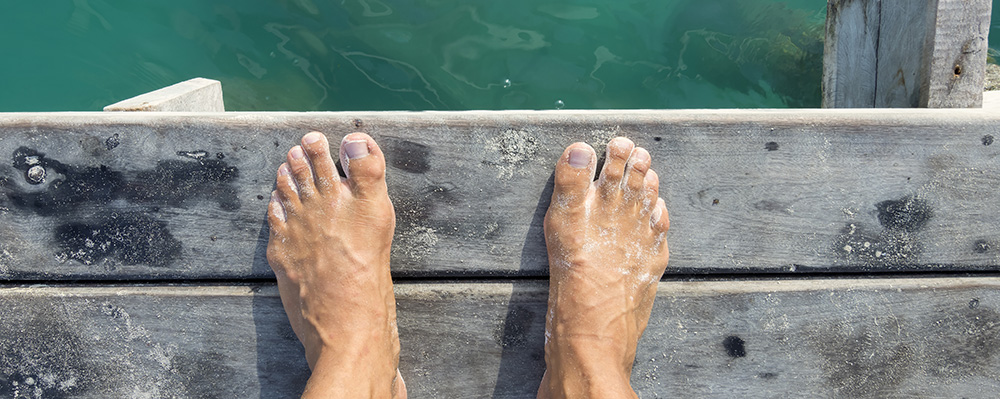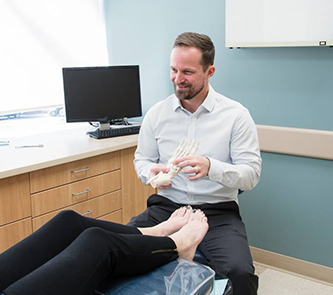Neuromas
That Elusive Invisible Pebble
If you have a neuroma, the feeling of it is probably driving you nuts.
Right near the front of your foot, usually just beneath and between two of your toes, it feels like there’s a pebble there, or your sock is bunched up strangely. But shift as you might, it doesn’t really go away.
In fact, it can be downright painful! You might feel a tingling or burning sensation, like hot needles. It could be that your toes feel a bit numb, too. These feelings could be dull, only to suddenly shoot up in the ball of your foot while walking.
A neuroma is not fun, but there are things the podiatrists at our Portsmouth and Nashua offices can do to treat it.
Causes of Neuromas
 You likely don’t need to be told that nerves can be very sensitive instruments, but you might not know how some may respond when irritated.
When pressure, irritation, or damage occurs to a nerve, the tissue around the nerve may grow thicker. This could be an effort to protect the nerve, but it often leads to more overall irritation with you.
You might expect to feel a lump with a neuroma, but this is typically not the case. You may more likely feel the discomfort between your third and fourth toes.
A neuroma, while a growth, is not cancerous.
While the exact form of irritation that causes a neuroma can vary, some people are more prone to developing one than others. They include:
You likely don’t need to be told that nerves can be very sensitive instruments, but you might not know how some may respond when irritated.
When pressure, irritation, or damage occurs to a nerve, the tissue around the nerve may grow thicker. This could be an effort to protect the nerve, but it often leads to more overall irritation with you.
You might expect to feel a lump with a neuroma, but this is typically not the case. You may more likely feel the discomfort between your third and fourth toes.
A neuroma, while a growth, is not cancerous.
While the exact form of irritation that causes a neuroma can vary, some people are more prone to developing one than others. They include:
- Those who consistently wear high heels or shoes with toe boxes that are too tight, placing extra pressure on the ball of the foot.
- Those who already have bunions, hammertoes, or flat feet.
- Athletes who are heavy into running, skiing, and other sports where pressure is frequently placed on the ball of the foot.
How Are Neuromas Treated?
 Treatment options will vary on the severity of the neuroma, as well as the individual needs of a patient.
In most cases, conservative treatments will have a useful positive effect on finding relief.
This may include changing your footwear to something better-fitting or looser around the toes (it’s a sacrifice you’ll feel better about after the fact). Orthotic inserts can provide additional support and take extra pressure off the painful area, allowing better opportunities for healing.
Other recommendations may include periods of resting the affected foot, massaging and stretching the foot/toes, icing the painful area, and exercises to strengthen muscles that influence the site of the neuroma and provide better support.
If sports or physical activity have been lending to your neuroma, we will most likely need to alter your training, workouts, and/or equipment to keep excess pressure of the nerve. We don’t want to keep you away from activities you love, though; just make sure you can enjoy them without having to worry about a neuroma becoming worse or coming back.
If conservative treatments are not providing the right amount of relief, other options may be considered. Corticosteroid injections can reduce swelling and pain at the site of the neuroma, aiding comfort and healing.
In some uncommon cases, as a last resort, surgery may be necessary to either relieve the pressure surrounding a nerve (decompression) or remove the nerve entirely. Conservative treatments will almost always be attempted first before considering these options.
Treatment options will vary on the severity of the neuroma, as well as the individual needs of a patient.
In most cases, conservative treatments will have a useful positive effect on finding relief.
This may include changing your footwear to something better-fitting or looser around the toes (it’s a sacrifice you’ll feel better about after the fact). Orthotic inserts can provide additional support and take extra pressure off the painful area, allowing better opportunities for healing.
Other recommendations may include periods of resting the affected foot, massaging and stretching the foot/toes, icing the painful area, and exercises to strengthen muscles that influence the site of the neuroma and provide better support.
If sports or physical activity have been lending to your neuroma, we will most likely need to alter your training, workouts, and/or equipment to keep excess pressure of the nerve. We don’t want to keep you away from activities you love, though; just make sure you can enjoy them without having to worry about a neuroma becoming worse or coming back.
If conservative treatments are not providing the right amount of relief, other options may be considered. Corticosteroid injections can reduce swelling and pain at the site of the neuroma, aiding comfort and healing.
In some uncommon cases, as a last resort, surgery may be necessary to either relieve the pressure surrounding a nerve (decompression) or remove the nerve entirely. Conservative treatments will almost always be attempted first before considering these options.
Don’t Let a Neuroma Make You Reluctant to Step Out!
A neuroma can really make someone think twice about something as simple as going for a walk. All the more reason to get things taken care of at Northeast Foot and Ankle! We’ve helped patients from Newburyport, Exeter, Hampton, and even all the way up to York, Maine, so let us help you too.
Call our offices in Nashua or Portsmouth at (603) 431-6070 and we will schedule an appointment as soon as possible. As part of our exam, it may help to have answers to some of these questions in mind:
- When did the pain begin?
- Do you participate in physical activity? Which ones and how often?
- What kinds of shoes do you wear most often?
- Do certain shoes or activities increase or lessen your pain?
These will be a great start toward reaching a diagnosis and solutions.
Pay Your Bill
Make a payment online through our payment portal or Care Credit!
Portsmouth Office
14 Manchester Square, Suite 250
Portsmouth, NH 03801
Nashua Office
17 Riverside Street, Suite 205
Nashua, NH 03062
Website Hosted by SC Digital



